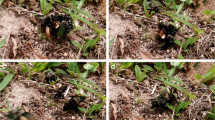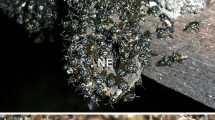Summary
Of the eight species of halictine bees whose mating behavior was studied,Augochlora pura (Augochlorini) andLasioglossum zephyrum (Halictini) were investigated in the greatest detail. Halictine bees have a short, simple courtship. Copulation occurs in the male-above position and its duration, 4 to about 340 seconds, varies significantly among species. Females resisted most mating attempts of males and usually mated only once. Males inseminated more than one female.
Males discriminated between conspecific females and those of other species; they did not make significantly more contacts with living, mobile females than with immobile ones killed by freezing. Female odors ofL. zephyrum andA. pura include aphrodisiacs; at least the former has a sex attractant which may be the same compound as the aphrodisiac. Virgin females ofL. zephyrum 2 to 8 days old produce aphrodisiac; it may be present throughout life. Some halictine females were highly attractive to males for up to 15 days, even after the females had mated. Aphrodisiac caused males ofL. zephyrum andA. pura to pounce upon 3 mm black India ink dots, which they probably mistook for females. Heads, mesosomas, and metasomas of females ofL. zephyrum all bore aphrodisiac.
Zusammenfassung
Von den acht Halictusarten, deren Paarungsverhalten studiert wurde, sindAugochlora pura (Auglochlorini) undLasioglossum zephyrum (Halictini) am genauesten untersucht worden. Halictusbienen haben eine einfache, kurze Balz. Bei der Kopulation reiten die Männchen auf, und die Kopulationsdauer (4 bis ungefähr 340 sec) ist signifikant unterschiedlich bei den einzelnen Arten. Die Weibchen widersetzen sich den meisten Paarungsversuchen der Männchen und kopulieren gewöhnlich nur einmal. Die Männchen begatten mehr als ein Weibchen.
Die Männchen unterschieden arteigene Weibchen von solchen anderer Arten. Sie nahmen nicht signifikant mehr Kontakt auf mit lebenden Weibchen als mit unbeweglichen, die durch Einfrieren getötet waren. Duftstoff der Weibchen vonL. zephyrum undA. pura enthält Aphrodisiakum; zumindestL. zephyrum hat einen Sexuallockstoff, der wahrscheinlich mit dem Aphrodisiakum identisch ist. Zwei bis drei Tage alte, unbegattete Weibchen dieser Art produzieren ein Aphrodisiakum, welches vermutlich während der gesamten Lebensspanne vorhanden ist. Einige weibliche Halictinae waren bis zu 15 Tagen hoch attraktiv für die Männchen, sogar nachdem die Weibchen schon kopuliert hatten. Das Aphrodisiakum veranlasste Männchen vonL. zephyrum undA. pura auf 3 mm grosse, schwarze Tuschepunkte zu springen, die sie wohl für Weibchen hielten. Die Duftstoffe aus den Köpfen, Meso- und Metasomas von weiblichenL. zephyrum enthielten alle das Aphrodisiakum.
Similar content being viewed by others
Literature Cited
Barrows (E. M.), 1973.—Soil nesting by wood-inhabiting halictine bees,Augochlora pura andLasioglossum coeruleum (Hymenoptera: Halictidae).J. Kansas Entomol. Soc., 46, 496–499.—Barrows (E. M.) 1974a. Aggregation behavior and response to sodium chloride in females of a solitary bee,Augochlora pura (Hymenoptera: Halictidae).Florida Entomol. 57, 189–193.—Barrows (E. M.) 1974b. Pheromones characteristic of individuals inLasioglossum zephyrum. Abstract.J. Kansas Entomol. Soc., 47, 540.—Barrows (E. M.) 1975a. Mating behavior in halictine bees (Hymenoptera: Halictidae). Ph. D. dissertation, University of Kansas.—Barrows (E. M.) 1975b. Mating behavior in halictine bees (Hymenoptera: Halictidae): II, Microterritorial and patrolling behavior of males ofLasioglossum rohweri. Z. Tierpsychol. (in press).—Barrows (E. M.) 1975c. Individually distinctive odors in an invertebratc.Behav. Biol., 15, 57–64.—Barrows (E. M.). 1975d. Mating behavior in halictine bees (Hymenoptera: Halictidae): I, Patrolling and age specific behavior in males.J. Kansas Entomol. Soc. (in press).
Barrows (E. M.), Bell (W. J.), andMichener (C. D.), 1975.—Individual odor differences and their social functions in insects.Proc. Natl. Acad. Sci., U.S.A., 72, 2824–2828.
Batra (S. W. T.), 1964.—Behavior of the social bee,Lasioglossum zephyrum, within the nest (Hymenoptera: Halictidae).Ins. Soc., 11, 159–186.—Batra (S. W. T.) 1966 The life cycle and behavior of the primitively social beeLasioglossum zephyrum (Halictidae).Univ. Kansas Sci. Bull., 46, 359–423.
Bell (W. J.), 1974.—Recognition of resident and non-resident individuals in intraspecific nest defense of a primitively eusocial halictine bee.J. Comp. Physiol., 93, 195–202.
Bell (W. J.) andHawkins (W. A.), 1974.—Patterns of intraspecific agonistic interactions involved in nest defense of a primitively cusocial halictine bee.J. Comp. Physiol., 93, 183–193.
Bell (W. J.), Breed (M. D.), Richards (K. W.) andMichener (C. D.), 1974.—Social, stimulatory, and motivational factors affecting nest defense in a primitively social bee.J. Comp. Physiol., 93, 173–181.
Bohart (G. E.), 1950.—Observations on the mating habits of halictid bees.Pan-Pac. Entomol., 26, 34–35.
Breed (M. D.), 1974.—The life cycle and behavior of a primitively social bee,Lasioglossum rohweri (Hymenoptera: Halictidae).J. Kansas Entomol. Soc., 48, 64–80.
Brothers (D. J.) andMichener (C. D.), 1974.—Interactions in colonies of primitively social bees. III. Ethometry of division of labor inLasioglossum zephyrum (Hymenoptera: Halictidae).J. Comp. Physiol. 90, 129–168.
Butler (C. G.), 1964.—Pheromones in sexual processes in insects.Insect Reproduction, Symposium No. 2. Roy. Entomol. Soc. London, 66–77.—Butler (C. G.) 1967. A sex attractant acting as an aphrodisiac in the honeybee (Apis mellifera L.).Proc. Roy. Entomol. Soc. London, A., 42, 71–76.—Butler (C. G.) 1971. The mating behaviour of the honeybee (Apis mellifera L.).J. Entomol., 46, 1–11.
Fitch (H. S.), 1965.—The University of Kansas Natural History Reservation in 1965.Univ. Kansas Mus. Nat. Hist. Misc. Publ., No.42, 60 p.
Free (J. B.), 1971.—Stimuli eliciting mating behaviour of bumblebee (Bombus pratorum) males.Behaviour, 40, 55–61.
Kamm (D. R.), 1974.—Effects of temperature, day length and number of adults on the size of cells and offspring in a primitively social bee (Hymenoptera: Halictidae).J. Kansas Entomol. Soc., 41, 8–18.
Kerr (W. E.), Zucchi (R.), Nakadaira (J. T.) andBütolo (J. E.), 1962. —Reproduction in the social bees.J. N. Y. Entomol. Soc., 70, 265–276.
Kullenberg (B.), 1956.—Field experiments with chemical sexual attractants on aculeate Hymenoptera males I.Zool. Bidrag Fran Uppsala, 31, 253–254.—Kullenberg (B.) 1973. Field experiments with chemical sexual attractants on aculeate Hymenoptera males II.Zoon Suppl., 1, 31–42.
May (D. G.) andStockhammer (K. A.), 1968.—A method of mass colonization of native bees in artificial substrate.J. Kansas Entomol. Soc., 41, 339–341.
Michener (C. D.) andBrothers (D. J.), 1974.—Interactions in colonies of primitively social bees. III. Ethometry of division of labor inLasioglossum zephyrum (Hymenoptera: Halictidae).J. Comp. Physiol., 90, 129–168.
Michener (C. D.), Brothers (D. J.) andKamm (D. R.), 1971a. — Interactions in colonies of primitively social bees: 1, Artificial colonies ofL. zephyrum.Proc. Nat. Acad. Sci., U.S.A., 68, 1241–1245—Michener (C. D.), Brothers (D. J.), andKamm (D. R.) 1971b. Interactions in colonies of primitively social bees: II, Some queen worker relations inLasioglossum zephyrum. J. Kansas Entomol. Soc., 44, 276–279.
Michener (C. D.) andWille (A.) 1961.—The bionomics of a primitively social bee,Lasioglossum inconspicuum.Univ. Kansas Sci. Bull., 42, 1123–1202.
Ordway (E.), 1966.—The bionomics ofAugochlorella striata andA. persimilis in eastern Kansas (Hymenoptera: Halictidae).J. Kansas Entomol. Soc., 39, 270–313.
Priesner (E.), 1973.—Reaktionen von Riehrezeptoren männlicher Solitärbienen (Hymenoptera, Apoidea) auf Inhaltstoffe vonOphyrs-Blüten.Zoon Suppl., 1, 43–54.
Sakagami (S. F.) andFukuda (H.), 1972.—Life of a Japanese eusocial halictine bee,Lasioglossum duplex, out of brood rearing season (Hymenoptera: Halictidae).Ins. Soc., 19, 137–152.
Sokal (R. R.) andRohlf (F. J.), 1969.—Biometry. The principles and practice of statistics in biological research.W. H. Freeman and Co., Publ., San Francisco, 776 p.
Stockhammer (K. A.), 1966.—Nesting habits and life cycle of a sweat bee,Augochlora pura (Hymenoptera: Halictidae).J. Kansas Entomol. Soc., 99, 157–192.—Stockhammer (K. A.) 1967. Some notes on the biology of the blue sweat bee,Lasioglossum coeruleum (Hym., Apoidea: Halictidae).J. Kansas Entomol. Soc., 40, 177–189.
Author information
Authors and Affiliations
Additional information
Contribution number 1554 from the Department of Entomology, University of Kansas, Lawrence, Kansas, 66045, U.S.A.
Rights and permissions
About this article
Cite this article
Barrows, E.M. Mating behavior in halictine bees (Hymenoptera: Halictidae): III. Copulatory behavior and olfactory communication. Ins. Soc 22, 307–331 (1975). https://doi.org/10.1007/BF02223079
Received:
Accepted:
Issue Date:
DOI: https://doi.org/10.1007/BF02223079




